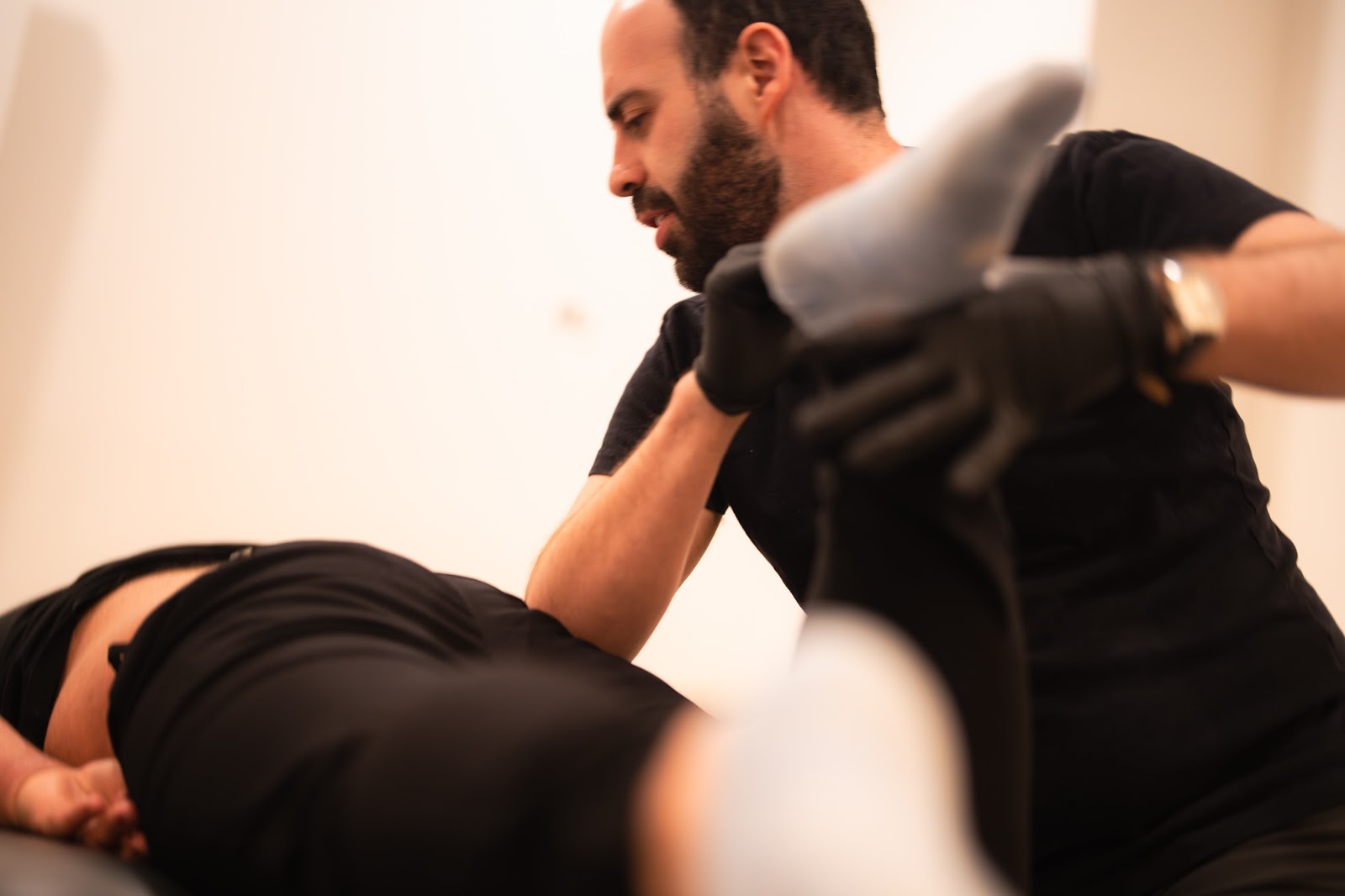If you’re a man experiencing unexplained pelvic discomfort, pain during sitting, or persistent urinary or sexual issues, you might be dealing with a little-known condition called pudendal nerve entrapment (PNE). PNE occurs when an entrapped pudendal nerve leads to nerve compression, resulting in chronic pelvic pain. It’s often misunderstood, misdiagnosed, and—worst of all—left untreated.
This blog will walk you through what pudendal nerve entrapment is, what causes it, how to identify it, and most importantly, how physical therapy can play a major role in recovery.
What Is Pudendal Nerve Entrapment?
The pudendal nerve is one of the main nerves in the pelvis. It runs from the lower back through a small canal in the pelvis (called Alcock’s canal) and branches out to serve the genitals, anus, and perineum (the area between the genitals and anus).
The pudendal nerve supplies motor and sensory innervation to the perineal region. It ncludes the external genitalia and anal sphincter, playing a crucial role in continence, sensation, and sexual function. It controls sensation and some muscle movements in that region, including the pelvic floor.
“The main branches of the pudendal nerve include the perineal branch, dorsal nerve, and inferior anal nerve. The perineal branch innervates the perineal muscles and skin, the dorsal nerve provides sensation to the penis in males and the clitoris in females, and the inferior anal nerve supplies motor innervation to the external anal sphincter and sensory innervation to the anal canal.”
When this nerve becomes compressed, irritated, or entrapped—often between ligaments or by tight muscles in the pelvis—it can lead to a painful condition called pudendal neuralgia. Pudendal nerve compression is a common cause of these symptoms. The resulting nerve pain can feel like burning, stabbing, aching, or numbness in the genitals, perineum, or rectum.
After passing through Alcock’s canal, the pudendal nerve is susceptible to entrapment, which can result in pudendal canal syndrome—a specific form of nerve entrapment within the pudendal canal.
Though it’s not widely recognized, pudendal nerve entrapment can affect both men and women. Symptoms of pudendal neuralgia may include genital numbness, sexual dysfunction, and bladder or bowel issues. Men, however, often report symptoms like:
- A dull or sharp ache in the perineum or lower pelvis
- A feeling of “sitting on a golf ball” or lump in the groin
- Erectile dysfunction that doesn’t respond to typical treatments
- Urinary urgency, frequency, or incomplete emptying
- Pain that worsens while sitting and improves when standing or lying down
Understanding Pudendal Nerve Pain (Pudendal Neuralgia)
Pudendal neuralgia is a type of chronic pain that stems from irritation or damage to the pudendal nerve. Chronic pudendal neuralgia is a long-term condition that can be associated with chronic perineal pain, pelvic and perineal pain, and other chronic pain syndromes. It may come and go—or it might persist and affect your quality of life significantly. Because symptoms vary and mimic other conditions, it’s frequently misdiagnosed as prostatitis, pelvic floor dysfunction, or even psychological distress.
The pain may be:
- Sharp, burning, or electric-shock-like
- Localized to the penis, scrotum, perineum, anus, or inner thighs, with pelvic and perineal pain being common manifestations
- Made worse by activities like cycling, squatting, or even sitting
If left untreated, it can contribute to anxiety, depression, and withdrawal from physical or intimate activities. Some patients experience persistent pain despite treatment, which can significantly affect daily activities.
Symptoms of Pudendal Nerve Entrapment
Pudendal nerve entrapment can present with a wide range of symptoms, often making daily life challenging. The most common sign is persistent pelvic pain, which may feel like a burning pain or numbness in the genital and anal regions.
Many people notice that their discomfort worsens when sitting and eases when they stand or lie down. This nerve entrapment can also lead to urinary frequency, constipation, or even painful bowel movements, making routine activities uncomfortable.
Sexual dysfunction is another frequent concern, with some individuals experiencing erectile dysfunction, painful ejaculation, or a decrease in sexual sensation. Others may describe a sensation of having a foreign object in the rectum or vagina, which can be both distressing and confusing. Because these symptoms can significantly impact quality of life. It’s important to seek an accurate diagnosis and appropriate treatment for pudendal nerve entrapment as soon as possible.
Causes of Pudendal Neuralgia?
Pudendal nerve entrapment typically results from nerve compression, which occurs when the pudendal nerve is pinched or irritated along its path through the pelvis. This compression may happen between ligaments, within tight spaces like Alcock’s canal, or from overactive pelvic floor muscles.
Pudendal neuralgia caused by nerve entrapment is often due to compression of nerve fibers at specific anatomical sites, leading to neuropathic pain that can worsen with sitting. The nerve fibers transmit pain signals, and their compression results in the characteristic symptoms of pudendal nerve entrapment syndrome. Prolonged sitting—especially on hard surfaces—can lead to chronic compression of the perineal region, placing constant stress on the nerve. Activities such as cycling or horseback riding can produce similar effects through repetitive pressure and friction.
Trauma, including falls or accidents that impact the lower back or pelvis, may also lead to pudendal nerve entrapment syndrome, especially when there is bruising or misalignment in the pelvic structures. Pelvic trauma is a recognized cause, as it can damage or entrap the pudendal nerve and its fibers, resulting in pain and dysfunction.
Surgical procedures in the pelvic or perineal region can leave behind scar tissue, creating adhesions that further compress the nerve. Chronic straining due to constipation or heavy lifting may also contribute to gradual injury. In some individuals, the nerve may be compressed by benign or malignant tumors, cysts, or anatomical abnormalities, although these cases are rarer. Identifying and treating the root source of nerve compression—whether muscular, structural, or surgical—is key to relieving symptoms.
When Is Decompression Surgery Considered?
When conservative treatments like physical therapy, nerve blocks, and medication do not provide adequate relief, pudendal nerve decompression surgery may be recommended. This surgical procedure involves carefully releasing the pudendal nerve from the tissues or ligaments compressing it—most commonly between the sacrospinous and sacrotuberous ligaments or within Alcock’s canal. Surgical decompression, including minimally invasive approaches like laparoscopic pudendal nerve decompression, aims to relieve nerve compression and provide pain relief.
Decompression surgery is typically reserved for individuals who meet specific diagnostic criteria, such as a positive response to a diagnostic pudendal nerve block and persistent pain or symptoms that have not improved with non-invasive care. Persistent pain despite conservative treatment is a key reason for considering surgical intervention. Because this is a complex and delicate procedure, it should be performed by surgeons who specialize in pelvic neuropathies. While not everyone is a candidate, those who undergo successful decompression may experience significant relief from pain and a better quality of life. However, surgery is not a guaranteed solution and some patients may continue to experience persistent pain even after intervention, so it should be considered only after thorough evaluation and exploration of other options.
How Do You Diagnose Pudendal Nerve Entrapment?
The diagnosis of pudendal nerve entrapment is a structured process that involves clinical evaluation based on established criteria, neurophysiological testing, and advanced imaging techniques.
Diagnosing pudendal nerve entrapment can be tricky. It’s not something you can see on a typical X-ray or even a standard MRI. Instead, diagnosis relies on a combination of clinical symptoms, physical examination, and sometimes specialized tests. Pudendal nerve entrapment syndrome is recognized as a clinical entity with specific diagnostic criteria, including history, physical examination, nerve blocks, and imaging such as MRI or ultrasonography to confirm nerve entrapment and rule out other causes.
When considering what conditions to rule out, sacroiliac joint dysfunction and chronic pelvic pain syndrome should be included in the differential diagnosis, along with other causes of pelvic or perineal pain.
Here’s how the process typically goes:
1. Clinical Evaluation
A thorough history of your symptoms, especially their relation to sitting and whether they change with movement, gives the first clues. Pudendal neuropathy is a broader term that refers to nerve injury or damage from various causes, such as trauma, childbirth, or compression, and may or may not involve entrapment. Pudendal neuralgia caused by pudendal nerve entrapment is a specific subset, where nerve compression leads to chronic pain, and is diagnosed using established criteria. Doctors will often follow a set of diagnostic criteria, including:
- Pain in the pudendal nerve area
- Worsening pain when sitting
- No pain when lying down or at night
- No loss of sensation or motor function
- Temporary relief from a diagnostic pudendal nerve block
2. Diagnostic Pudendal Nerve Block
A local anesthetic is injected near the pudendal nerve in a procedure known as pudendal nerve block injections, which serve as both a diagnostic and therapeutic tool. If your pain improves for a few hours or days afterward, it confirms the pudendal nerve is involved.
Pain medication, such as local anesthetics or corticosteroids, may be used in conjunction with these nerve block injections to provide temporary relief and reduce inflammation. This procedure also helps guide treatment options.
3. Imaging and Nerve Tests
High-resolution MRI, CT scans, or pelvic floor EMG may be used to rule out structural problems. These are less about seeing the nerve directly and more about excluding other conditions.
Can It Be Treated Without Surgery? Yes. Here’s How.
While decompression surgery is an option in more severe cases, non-surgical treatment is highly effective for many people—especially when started early. This is where pelvic floor physical therapy plays a central role.
Nerve Compression: How It Affects the Pudendal Nerve
Nerve compression is a key factor in the development of pudendal neuralgia and chronic pelvic pain. The pudendal nerve runs through the pelvic floor muscles and passes close to several structures, including the ischial spine, sacrospinous ligament, and the pudendal canal.
When these surrounding tissues—such as tight muscles, ligaments, or tendons—press on the nerve, it can lead to symptoms like numbness, tingling, and neuropathic pain in the pelvic area.
Prolonged or repeated compression can cause lasting nerve damage, resulting in chronic neuropathic pain that is often difficult to manage without targeted treatment. Understanding exactly where and how the pudendal nerve is being compressed is vital for choosing the right therapy. Whether that involves physical therapy to relax the pelvic floor, nerve blocks, or, in some cases, surgical intervention. By addressing nerve compression early, it’s possible to reduce pain and prevent long-term complications.
How Physical Therapy Helps Pudendal Neuralgia

In some cases, muscle relaxants may be prescribed alongside physical therapy to help reduce pelvic floor spasm and improve the effectiveness of treatment.
A specially trained pelvic health physical therapist can:
- Teach you how to relax and lengthen the pelvic floor muscles
- Guide you through exercises to strengthen weak muscles and improve coordination
- Use manual therapy techniques to release tight or tender areas
- Provide education on posture, body mechanics, and lifestyle modifications
✅ Release Pelvic Floor Tension
Overactive or tight pelvic floor muscles can compress the pudendal nerve. Therapy focuses on relaxing these muscles through manual techniques and guided exercises.

✅ Correct Postural Imbalances
Poor posture or spinal alignment may strain nerves in the pelvis. PT helps you improve posture to reduce unnecessary pressure on the nerve.
✅ Identify Aggravating Movements
A trained eye can spot which activities or movements irritate your nerve—and help you adjust or eliminate them safely.
✅ Teach Safe Stretching & Mobility
Stretches that target hip rotators, hamstrings, and the lower back can open up tight areas that may be indirectly affecting your nerve.
✅ Support Bladder and Bowel Function
Therapists can help you develop habits that prevent straining, such as healthy bathroom posture, breathing techniques, and dietary changes.
✅ Incorporate Pain Management Tools
Devices like TENS units can help block pain signals from the pudendal nerve. Therapists guide proper use for maximum benefit. In cases where pain is refractory to conservative treatments, advanced neuromodulation techniques such as sacral nerve stimulation and spinal cord stimulation may be considered. This can use for complex or persistent neuropathic pain conditions.
Physical therapy is especially helpful when nerve entrapment is caused by muscle compression, not a structural defect. It is something quite common in active men or those who sit for long periods. Persistent genital arousal disorder, which can be associated with pudendal nerve compression, may also benefit from similar pain management strategies.
Lifestyle Changes for Managing Pudendal Neuralgia
Making thoughtful lifestyle changes can have a significant impact on managing pudendal neuralgia symptoms and improving overall quality of life. One of the most effective strategies is to avoid activities that trigger or worsen pain. Examples are prolonged sitting or cycling. Using ergonomic cushions, taking frequent breaks, and adjusting your daily routine can help minimize discomfort.
Maintaining a healthy weight and engaging in regular, gentle exercise can support pelvic health. It can reduce pressure on the pudendal nerve. Practicing good posture and incorporating pelvic floor physical therapy into your routine can strengthen pelvic muscles. Additionally, it can improve bladder and bowel function. Stress management techniques, like meditation and deep breathing, are also valuable tools for coping with chronic pain and reducing symptom flare-ups.
By adopting these lifestyle changes and working closely with a physical therapist, individuals with pudendal neuralgia can take proactive steps to manage their symptoms, regain control, and enhance their quality of life.
When Is Surgery Necessary?
If conservative treatments fail to relieve symptoms over several months, pudendal nerve decompression surgery may be considered. This involves surgically releasing the nerve from surrounding tissues to reduce compression. It’s a complex procedure and should be done by a surgeon experienced in pelvic nerve disorders. Pre-surgical nerve blocks are often used to predict whether surgery will help.
Managing Chronic Pudendal Pain
Living with chronic pudendal pain can be both physically draining and emotionally overwhelming. Especially when the symptoms persist without a clear explanation or diagnosis. Fortunately, there is a range of treatment options available that can help patients manage pain and improve their quality of life.
A comprehensive approach typically includes pelvic floor physical therapy as the foundation. It aimed at releasing muscle tension, restoring mobility, and reducing nerve irritation. Alongside therapy, patients often benefit from pain management techniques. Examples are the use of TENS (transcutaneous electrical nerve stimulation) units, which deliver low-level electrical currents to disrupt pain signals.
Medications for nerve-related pain—such as gabapentin, amitriptyline, or duloxetine—can also be prescribed to help calm nerve activity and reduce discomfort. For some, pudendal nerve blocks or pulsed radiofrequency treatments may be used to target the source of the pain more directly.
Additionally, psychological support, particularly cognitive behavioral therapy (CBT), can be an important part of pain management. It helps patients develop better coping mechanisms and address the emotional strain that often accompanies chronic pain.
Lifestyle modifications are equally important in reducing symptom flare-ups. This may involve adjusting exercise routines, using ergonomic cushions when sitting, avoiding activities that aggravate the nerve, and improving bowel and bladder habits to avoid straining. With the right combination of interventions—and the support of a skilled care team—many patients are able to manage their symptoms effectively and regain a sense of normalcy in their daily lives.
Take the First Step Toward Relief
At PELIVS NYC, we understand how difficult pudendal nerve pain can be, both physically and emotionally. That’s why we offer expert evaluation and individualized pelvic floor therapy to help you regain control over your health.
We also offer a FREE 15-minute teleconsultation so you can speak to a professional, ask questions, and explore whether therapy might be right for you.
You don’t have to live in pain. Get the right diagnosis, the right treatment, and your life back.
Related Blog: Pudendal Neuralgia: PT Is Your Treatment

